
| Determination of micronucleus frequency by acridine orange fluorescent staining in peripheral blood reticulocytes of mice treated topically with different lubricant oils and cyclophosphamide C.R. Oliveira-Martins1 and C.K. Grisolia2 1Superintendência de Fiscalização, Agência Nacional do Petróleo, Brasília, DF, Brasil 2Departamento de Genética e Morfologia, Instituto de Ciências Biológicas, Universidade de Brasília, Brasília, DF, Brasil Corresponding author: C.K. Grisolia E-mail: [email protected] Genet. Mol. Res. 6 (3): 566-574 (2007) Received June 4, 2007 Accepted August 6, 2007 Published September 30, 2007 ABSTRACT. To ascertain whether used and re-refined lubricant oil absorbed through the skin can produce a genotoxic effect or cytotoxicity in mouse bone marrow cells, we examined the induction of micronucleated erythrocytes of peripheral blood after cutaneous application. Both re-refined and used lubricant oils showed a weak but significant induction of micronucleated polychromatic erythrocytes compared with control, while virgin oil did not show micronucleus induction. Cyclophosphamide (CP) was used not only as positive control but also to compare the sensitivity between intraperitoneal and dermal routes of administration of the test compounds in mice. The efficacy of intraperitoneal injection of CP is well known. On the other hand, dermal exposure is not so common and when CP was diluted in glycerin statistically significant values (P = 0.0036) of micronuclei were also found. Topically applied lubricant oils (virgin, re-refined and used) have the capacity to interfere with mouse bone marrow hematopoiesis evidenced by a statistically significant decrease in the proportion of polychromatic erythrocytes in the peripheral blood. Physical and chemical analysis revealed that used oil is more viscous than other lubricants, suggesting the presence of insoluble compounds, oxidized products and water as well as aromatic hydrocarbons. Used oil differs from other lubricant oils in metal and polyaromatic hydrocarbon content. Re-refined oil revealed a neutral value typical of pure mineral oil. This assay is an important tool to evaluate environmental pollutants that cause genotoxicity and/or cytotoxicity through skin exposure. Key words: Micronucleus, Cytotoxicity, Lubricant oils, Cyclophosphamide INTRODUCTION Lubricants are substances intended to reduce friction between surfaces in relative motion. They also serve other secondary purposes, such as removal or transfer of heat, removal of waste products and contaminants, protection of surfaces against corrosion or rust, and as a dielectric medium. Mineral-based oils are prepared from naturally occurring crude petroleum oils. Hydrocarbons are the predominant compounds besides some sulfur, oxygen, nitrogen, and traces of a number of metals. The hydrocarbons are normally a complex mixture of aromatic naphthenes and paraffins. In relation to health hazards, all crude oils contain polycyclic aromatic hydrocarbons (PAH), and some of them are known to be carcinogenic, such as benzene, toluene and xylene (IARC, 1987; Williams and Weisburger, 1996; WHO, 1993, 2000). Although the contents of PAH vary with crude source, the proportion and types of such compounds in finished base oils are mainly determined by the refining processes (Eyre et al., 1987). Chronic occupational exposure to petroleum derivatives may be considered as posing a genotoxic risk. In particular, workers in the petroleum-processing industry and gas station attendants experience relatively high-level exposure to fuel vapors and other petroleum-derivative products. Many studies have reported an increased number of chromosomal aberrations and micronucleated cells in humans occupationally exposed to these kinds of compounds (Zhou et al., 1986; Högstedt et al., 1991; Santos-Mello and Cavalcante, 1992; Carere et al., 1995; Çelik et al., 2003; Benites et al., 2006). Laffon et al. (2006) reported significantly increased DNA damage by the comet assay in a group of individuals engaged in the cleaning and autopsy of oil-contaminated birds. The volatility of this oil is low, due to its elevated content of high-molecular weight hydrocarbons. Skin toxicity to rats is considered low based on the acute lethal concentration assay (50%) of 3.0 g/kg (Concawe, 2006). With respect to lubricant oils, the Canadian Petroleum Products Institute considers that small urban producers, such as fast lubes and service stations, together with large industry, generates about 80% of all used oils (Concawe, 2006). Skin is a biological interface with the environment and functions as the first line of defense against noxious external stimuli such as ultraviolet and visible irradiation, pro-oxidant chemicals, infective agents and ionizing radiation (Fuchs and Packer, 1991). Exposure to engine lubricating oil, mainly through the skin by occupational exposure, has been associated with an excess of skin carcinomas (Clonfero et al., 1996). The micronucleus assay is widely used as a screening method for detecting the clastogenicity of chemicals in vivo. Mouse polychromatic peripheral erythrocytes are increasingly being used as alternative target cells. Hayashi et al. (1990) introduced a new method for the observation of micronucleated young erythrocytes using supravital staining with acridine orange. This method can distinguish very young micronucleated erythrocytes in peripheral blood stream before being trapped and destroyed by the spleen. To ascertain whether used and re-refined lubricant oil absorbed through skin can produce a genotoxic effect or cytotoxicity in bone marrow, we examined the induction of micronucleated erythrocytes as well as the relationship between polychromatic and normochromatic erythrocytes in mouse peripheral blood after cutaneous application. The aim of the present study was to analyze the genotoxic and cytotoxic effects of three kinds of lubricant motor oils - virgin, used and re-refined - related to physical and chemical characteristics using the micronucleus (MN) test in polychromatic erythrocytes and the relationship between polychromatic and normochromatic erythrocytes, respectively, in the peripheral blood of mice after dermal exposure. MATERIAL AND METHODS Chemicals Cyclophosphamide (CP; CAS 6055-19-2) was in the form of GENUXAL (ASTA Medica Laboratory). CP was dissolved in glycerin (Merck) and used as positive control for the MN assay. Three kinds of lubricant oils were tested: a) virgin oil - a mixture of various commercial lubricants considering the proportion of sales at gas stations in the local market; b) used oil - oil of car engines (carburetor or fuel injection type), collected from gas stations; c) re-refined oil - recycled used oil to restore the virgin lubricating properties. Both used and re-refined oils were obtained from a recycling company. In Brazil, gasoline is unleaded and is mixed with alcohol (ethanol) at a proportion of 22-25%. Animal treatments for micronucleus assay Swiss albino mice of both sexes from Central Animal Facility of the University of Brasília, 60 days old and weighing 30 ± 2 g, were allocated at random into groups of eight animals for eight different treatments: 1) control; 2) virgin oil - single application of 0.2 mL for 72 h, topically; 3) re-refined oil - single application of 0.2 mL for 72 h, topically; 4) used oil - single application of 0.2 mL for 72 h, topically; 5) CP - 25 mg/kg body weight for 24 h, intraperitoneally; 6) CP - 25 mg/kg body weight for 48 h, intraperitoneally; 7) CP - 40 mg/kg body weight in 0.2 mL glycerin for 72 h, single application topically, and 8) CP - 40 mg/kg in 0.2 mL glycerin daily for 72 h (3 x 72 h) topically. The animals were treated topically with the test compounds applied to a shaved 2-cm2 area of skin on the dorsal region (Figure 1). They were housed in individual cages to avoid transfer of test compound among animals by licking. 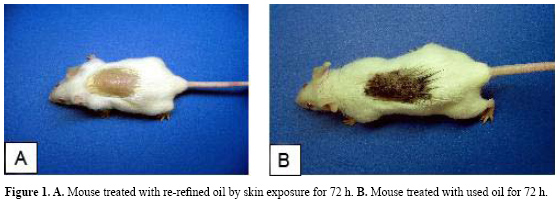
Sample preparation Animals were sacrificed by cervical dislocation and peripheral blood was collected by cardiac puncture after treatment to prepare blood smears. Acridine orange supravital-staining preparation was made according to the method of Hayashi et al. (1990). For each animal, two thousand polychromatic erythrocytes (PCEs) and two thousand normochromatic erythrocytes (NCEs) were examined. However, MN were scored only in PCEs. PCEs were identified by red fluorescing reticulum in the cytoplasm, and MN fluoresced greenish yellow (Figure 2). NCEs fluoresced as pale green. PCE/NCE relationship was also recorded as a sign of cytotoxicity. Two thousand cells were scored to measure the percentage of PCE among total erythrocytes. Slides were examined using a fluorescence Axioskop 2 Zeiss microscope. Statistical analysis was carried out using the Mann-Withney U-test, α = 5%. Differences in MN frequencies were determined comparing the oil-treated groups with the control group as well as the different CP treatment groups with the control group. This study was approved by the Animal Ethics Committee of the Institute of Biological Sciences of University of Brasília, number 67463/2006. 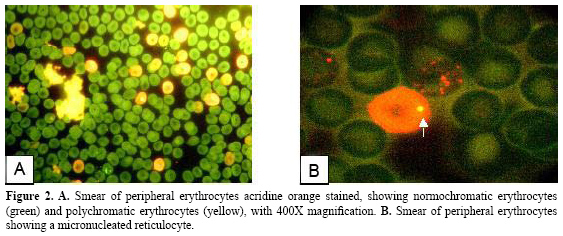
Chemical and physical properties The viscosity index was calculated using kinematic viscosity at 40º and 100ºC. Flash and fire points, detection of water in petroleum products, determination of additive elements, wear metals and contaminants, and total basic number were determined using methods recommended by the American Society for Testing and Materials - ASTM (Table 1). 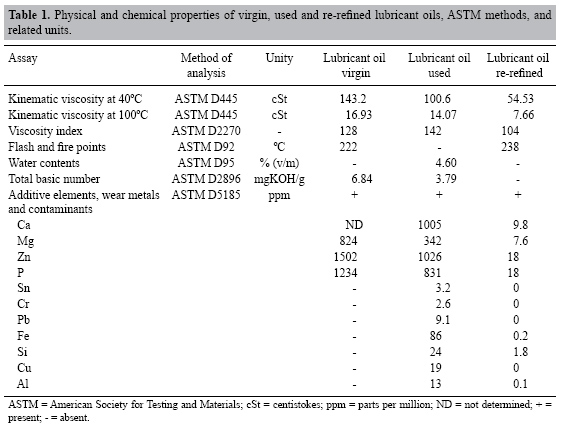
Infrared technique was used to compare differences in the compositions among lubricant types. The equipment selected was a Spectrum One FT-IR of Perkin Elmer Intruments with the following conditions of analysis: range scan starting at 4000 cm-1 and ending at 450 cm-1, scan number of 4 (oil sample was 4-fold scanned by the equipment), resolution of 4.0 cm-1, scan speed of 0.2 cm/s, and percent transmittance as the unit of intensity of bands (Figure 3). RESULTS Both re-refined and used lubricant oils showed MN PCE induction compared to the control (P = 0.0487 and P = 0.0105, respectively), while virgin oil did not show MN PCE induction (P = 0.6645). CP was used not only as positive control, but also to compare the sensitivity between intraperitoneal and dermal route of administration of the test compound. Single topical application of CP for 72 h increased the frequency of MN PCEs and caused cytotoxicity as well, shown by the decreased percentage of PCEs compared with NCEs in mouse peripheral blood (Table 2). Daily topical application of CP for three days showed a 10-fold induction of MN PCEs compared with control and a higher cytotoxicity (Table 2). We also found that topically applied lubricant oils (virgin, re-refined and used) have the capacity to interfere with mouse bone marrow hematopoiesis evidenced by a statistically significant decrease in the proportion of immature erythrocytes in the peripheral blood (Table 2). There were no animal deaths due to treatments. Physical and chemical analysis revealed that used oil is more viscous than other lubricant types, indicating the presence of water-insoluble compounds, oxidized products and water. Both the ASTM method and infrared technique (at 3400 cm-1 band) showed the presence of water in used oil and indicated the presence of aromatic hydrocarbons at 1631 and 1460 cm-1 bands, due to carbon double bonds causing axial deformation of the aromatic ring (Table 1 and Figure 3). Used lubricant oil showed the presence of metal residues, suggesting that car engines working at high temperature and friction can cause this contamination. The decreased total basic number in the used oil means that alkaline reserve, necessary to reduce acidity, was consumed, indicating acid contamination due to oxidation. Re-refined oil revealed a neutral value typical of pure mineral oil. 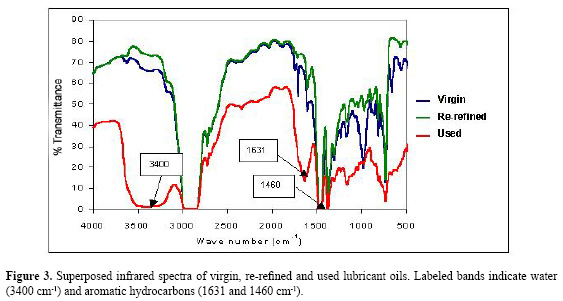
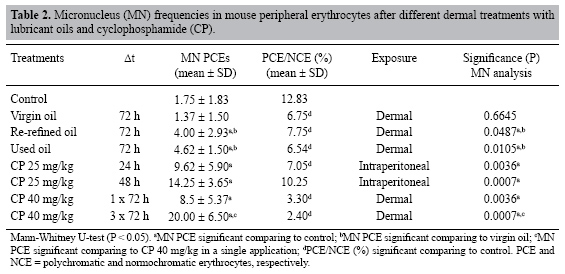
DISCUSSION Mineral oils are basically non-hazardous to skin. Occasional contacts, such as that occurring during car engine lubricating oil changing in the gas stations, do not present a risk to people. However, frequent and long-term exposures can result in health hazards and in a variety of skin diseases that are generally designated as dermatitis (Runge and Duarte, 1989). Concerns with the carcinogenic action of mineral oils started in 1968 in the UK Medical Research Council, which published a report whose salient conclusions included: 1) some fractions of certain crudes from which lubricating oils are refined have been shown to produce tumors on the skin of rabbits and mice; 2) solvent extraction methods in refining which remove PAH markedly reduce the carcinogenic activity of the refined lubricants, and 3) carcinogenicity of mineral oils appears to be related to the presence of PAH, some of which are known to be carcinogens (Jarvholm and Easton, 1990). However, new treatments can remove aromatic compounds including PAH almost entirely (Eyre et al., 1987). In this study, the genotoxicity found suggests that dermal exposure to used and re-refined lubricant oils could contribute to their carcinogenic risk. Studies have demonstrated that used oils from car engines contain carcinogens for laboratory animals and that this carcinogenic potential increases with its long-term use in engines (Eyre et al., 1987; Clonfero et al., 1996). The content of PAHs, metals, chlorinated solvents, products of incomplete combustion, glycols, and polychlorinated biphenyls found in the used oils may be responsible for its carcinogenicity as observed in Table 1 and Figure 3. Other kind of contaminants can be found due to chemicals added to improve the lubricating oil performance, due to physical or chemical changes occurring inside engines or from mixing with other oily fluids or liquid wastes during disposal (Eyre et al., 1987). The reason for a 72-h treatment was based on the high content of long-chain hydrocarbons and PAH present in the lubricating oils, which make its skin absorption difficult. The results of the MN test with re-refined oil and used oil can be considered of low magnitude due to the large intra-group standard deviation of the means (Table 2). Nonetheless, there was a significant but small increase in the MN frequencies, although cautious interpretation is required. Otherwise, there is a consensus that the risks to humans are essentially insignificant when good practices are adopted to minimize oil exposure and to take basic hygiene precautions, particularly with washing of exposed body parts (Eyre et al., 1987). The same procedures are not valid for used oils which have a higher content of toxic substances compared with virgin oil and re-refined oil. Many studies carried out in different test-systems have shown that petroleum derivatives can cause DNA damage (Carere et al., 1995; Clonfero et al., 1996; Zúñinga-Gonzáles et al., 2003; Horn et al., 2004; Çavas and Ergene-Gözükara, 2005). On the other hand, our results demonstrated that the skin is an important site of exposure to petroleum-derivative compounds with genotoxic and cytotoxic potential. Zúñinga-Gonzáles et al. (2003) reported that topically applied 5-fluorouracil has the capacity to induce damage in mouse bone marrow stem cells in proportion to the dose used, as detected as micronuclei in peripheral blood. Different doses of the 5-fluorouracil cream used displayed genotoxic and cytotoxic effects, emphasizing the importance of using the correct dose when applying drugs topically. The efficacy of intraperitoneal injection of CP is well known. In this study, we could demonstrate that dermal exposure to CP is not a common route of treatment, and when CP was diluted in glycerin and topically applied, statistically significant values of MN PCEs were found compared with control (Table 2). Moreover, in our methodological approach we took into consideration the effectiveness of CP. When topically applied it should be done in concentrations higher than intraperitoneal injection, which is the most acute route of treatment. This is the reason why we used concentrations of 25 mg/kg body weight in the intraperitoneal treatments and 40 mg/kg body weight in the cutaneous treatments. Another serious environmental implication is the inappropriate management of used oil disposal. In different countries, an increasing concern about the environment makes reuse/recycling of mineral oils a necessity. Unfortunately, only a small percentage is currently recovered. The balance is lost during use or disposed in the environment in inappropriate ways. In developing countries, the collection systems are limited to some urban areas, and vendors do not assume any responsibility for the fate of the used oil. In conclusion, our results revealed that mouse skin is also a sensitive route to evaluate environmental pollutants with genotoxic characteristics and that both re-refined and used lubricating oils exhibit a potential genotoxicity and cytotoxicity compared with virgin oil. ACKNOWLEDGMENTS The authors thank Agência Nacional do Petróleo, FINATEC and Universidade de Brasília. REFERENCES Benites CI, Amado LL, Vianna RA and Martino-Roth MG (2006). Micronucleus test on gas station attendants. Genet. Mol. Res. 5: 45-54. Carere A, Antoccia A, Crebelli R, Degrassi F, et al. (1995). Genetic effects of petroleum fuels: cytogenetic monitoring of gasoline station attendants. Mutat. Res. 332: 17-26. Çavas T and Ergene-Gözükara S (2005). Induction of micronuclei and nuclear abnormalities in Oreochromis niloticus following exposure to petroleum refinery and chromium processing plant effluents. Aquat. Toxicol. 74: 264-271. Çelik A, Çavas T and Ergene-Gözükara S (2003). Cytogenetic biomonitoring in petrol station attendants: micronucleus test in exfoliated buccal cells. Mutagenesis 18: 417-421. Clonfero E, Nardini B, Marchioro M, Bordin A, et al. (1996). Mutagenicity and contents of polycyclic aromatic hydrocarbons in used and recycled motor oils. Mutat. Res. 368: 283-291. Concawe (2006). www.cppi-ca/Environmental_Protection. Accessed December 8, 2006. Eyre AR, Smith JD, Coker DT, Gilks JML, et al. (1987). Health aspects of lubricants. Concawe report No. 5/87, 1-43. Fuchs J and Packer L (1991). Oxidative stress. In: Oxidants and antioxidants (Sies H, ed.). Academic Press Limited, London, 559-583. Hayashi M, Morita T, Kodama Y, Sofuni T, et al. (1990). The micronucleus assay with mouse peripheral blood reticulocytes using acridine orange-coated slides. Mutat. Res. 245: 245-249. Högstedt B, Holmen A, Karlsson A, Raihle G, et al. (1991). Gasoline pump mechanics had increased frequencies and sizes of micronuclei in lymphocytes stimulated by pokeweed mitogen. Mutat. Res. 263: 51-55. Horn RC, Rocha JA and Vargas VM (2004). Determination of sediment mutagenicity and cytotoxicity in an area subjected to petrochemical contamination. Mutagenesis 19: 445-451. IARC - International Agency for Research on Cancer (1987). Monograph on the evaluation of the carcinogenic risk: an updating of IARC Monographs. IARC, Lyon. Vol. 1-42 (Suppl 7): 17-74. Jarvholm B and Easton D (1990). Models for skin tumour risks in workers exposed to mineral oils. Br. J. Cancer 62: 1039-1041. Laffon B, Fraga-Iriso R, Pérez-Cadahía B and Méndez J (2006). Genotoxicity associated to exposure to Prestige oil during autopsies and cleaning of oil-contaminated birds. Food Chem. Toxicol. 44: 1714-1723. Runge PRF and Duarte G (1989). Aspectos de saúde em relação aos óleos minerais atualmente em uso Triboconcept. Editora Técnica Ltda., São Paulo, 283-290. Santos-Mello R and Cavalcante B (1992). Cytogenetic studies on gas station attendants. Mutat. Res. 280: 285-290. World Health Organization (WHO) (1993). Environmental Health Criteria 150: Benzene. World Heath Organization, Geneva. World Health Organization (WHO) (2000). Air Quality Guidelines for Europe. 2nd edn. WHO Regional Office for Europe, Copenhagen. Williams GM and Weisburger JH (1996). Chemical carcinogens. In: Toxicology - Basic science of poisons (Klaassen CD, Amdur MO and Doull J, eds.). McGraw-Hill, New York, 99-173. Zhou XT, Li LR, Cui MY, Yu RF, et al. (1986). Cytogenetic monitoring of petrochemical workers. Mutat. Res. 175: 237-242. Zúñinga-Gonzáles G, Torres-Bugarin O, Zamora-Peres A, Gómez-Meda BD, et al. (2003). Induction of micronucleated erythrocytes in mouse peripheral blood after cutaneous application of 5-fluorouracil. Arch. Med. Res. 34: 141-144. |
|